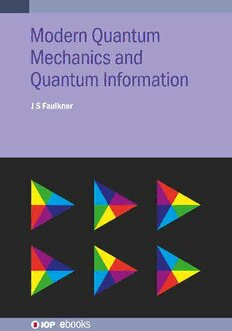Table Of ContentModern Quantum Mechanics
and Quantum Information
Modern Quantum Mechanics
and Quantum Information
J S Faulkner
Department of Physics, Florida Atlantic University, Boca Raton, Florida, FL, USA
IOP Publishing, Bristol, UK
ªIOPPublishingLtd2021
Allrightsreserved.Nopartofthispublicationmaybereproduced,storedinaretrievalsystem
ortransmittedinanyformorbyanymeans,electronic,mechanical,photocopying,recording
orotherwise,withoutthepriorpermissionofthepublisher,orasexpresslypermittedbylawor
undertermsagreedwiththeappropriaterightsorganization.Multiplecopyingispermittedin
accordancewiththetermsoflicencesissuedbytheCopyrightLicensingAgency,theCopyright
ClearanceCentreandotherreproductionrightsorganizations.
PermissiontomakeuseofIOPPublishingcontentotherthanassetoutabovemaybesought
atpermissions@ioppublishing.org.
JSFaulknerhasassertedhisrighttobeidentifiedastheauthorofthisworkinaccordancewith
sections77and78oftheCopyright,DesignsandPatentsAct1988.
ISBN 978-0-7503-2167-9(ebook)
ISBN 978-0-7503-2165-5(print)
ISBN 978-0-7503-2168-6(myPrint)
ISBN 978-0-7503-2166-2(mobi)
DOI 10.1088/978-0-7503-2167-9
Version:20211201
IOPebooks
BritishLibraryCataloguing-in-PublicationData:Acataloguerecordforthisbookisavailable
fromtheBritishLibrary.
PublishedbyIOPPublishing,whollyownedbyTheInstituteofPhysics,London
IOPPublishing,TempleCircus,TempleWay,Bristol,BS16HG,UK
USOffice:IOPPublishing,Inc.,190NorthIndependenceMallWest,Suite601,Philadelphia,
PA19106,USA
I would like to express my gratitude to the ladies in my life. My wife Dora and my
daughters Emilia and Lee Anne.
Contents
Preface xiii
Acknowledgement xiv
Author biography xv
1 Review of basics 1-1
1.1 About quantum mechanics 1-1
1.2 Hilbert space 1-2
1.3 Elementary quantum mechanics 1-4
1.4 Dirac and von Neumann 1-5
1.5 Rigged Hilbert space 1-6
1.6 Observables and Hermitean operators 1-10
1.7 The uncertainty relation 1-12
1.8 Commuting observables 1-14
1.9 Unitary operators 1-14
1.10 The Gaussian wave packet 1-15
1.11 Two-dimensional Hilbert space 1-16
1.12 Pairs of spins 1-22
1.13 Einstein, Podolsky, and Rosen 1-23
Problems 1-24
References 1-25
2 Non-relativistic quantum mechanics 2-1
2.1 Heisenberg’s matrix mechanics 2-1
2.2 The one-dimensional harmonic oscillator 2-2
2.3 Schrödinger’s wave mechanics 2-4
2.4 The one-dimensional harmonic oscillator (again) 2-6
2.5 Comparison of Heisenberg and Schrödinger theories 2-8
2.6 Wave mechanics in three dimensions 2-9
2.7 Angular momentum 2-10
2.8 Schrödinger equation for a spherically symmetric potential 2-14
2.9 Schrödinger equation for the hydrogen atom 2-15
2.10 Time-dependent wave equation 2-18
2.11 The time-evolution operator 2-20
2.12 The time dependence of Heisenberg’s operators 2-21
vii
ModernQuantumMechanicsandQuantumInformation
Problems 2-22
References 2-23
3 Relativistic quantum mechanics 3-1
3.1 The necessity for relativistic quantum mechanics 3-1
3.2 Klein–Gordon equation 3-1
3.3 Problems with the Klein–Gordon equation 3-4
3.4 Dirac theory 3-7
3.5 Proof of the Lorentz covariance of the Dirac equation 3-9
3.6 The fifth gamma matrix 3-15
3.7 Free particle solution of the Dirac equation 3-15
3.8 Angular momentum and spin 3-18
3.9 The magnetic moment of the electron 3-20
3.10 Scalar relativistic approximation 3-21
3.11 The Dirac theory of the hydrogen atom 3-23
3.12 Advantages and disadvantages 3-26
Problems 3-28
References 3-28
4 Symmetry 4-1
4.1 The importance of symmetry in physics 4-1
4.2 A simple example 4-2
4.3 Theory of finite groups 4-4
4.4 Representations of finite groups 4-6
4.5 Theory of infinite groups and Lie groups 4-9
4.6 Continuous groups in physics 4-10
4.7 Conservation laws from Noether’s theorem 4-16
4.8 Conservation laws from quantum mechanics 4-17
4.9 Continuous group representations 4-21
4.10 Groups of a Hamiltonian 4-25
4.11 Conclusions 4-26
Problems 4-27
References 4-27
5 Approximate methods 5-1
5.1 Rayleigh–Ritz variational method 5-1
5.2 Time-independent perturbation theory 5-6
viii
ModernQuantumMechanicsandQuantumInformation
5.3 Time-dependent perturbation theory 5-8
5.4 The two-level Hamiltonian 5-10
5.5 Spin magnetic resonance 5-11
5.6 The maser 5-13
5.7 Fermi’s golden rule 5-13
5.8 An atom interacting with a plane electromagnetic wave 5-16
5.9 Approximate methods that use computers 5-19
Problems 5-21
References 5-21
6 Scattering and Green’s functions 6-1
6.1 Potential scattering 6-1
6.2 Position representation 6-2
6.3 The spherical scatterer 6-4
6.4 The optical theorem 6-6
6.5 The Born approximation 6-7
6.6 Green’s function and its adjoint 6-8
6.7 Green’s function with a scatterer 6-9
6.8 The non-spherical scattering potential with bounded domain 6-10
6.9 Spectral theory from scattering theory 6-13
6.10 Krein’s theorem 6-13
Problems 6-16
References 6-17
7 A practical tool 7-1
7.1 The exact equations 7-1
7.2 Pauli exclusion principle 7-4
7.3 Atomic structure 7-5
7.4 The hydrogen molecule 7-6
7.5 Covalent bonding 7-12
7.6 Ionic bonding 7-15
7.7 Bonding in metals 7-21
7.8 Conclusions 7-22
Problems 7-22
Reference 7-23
ix

